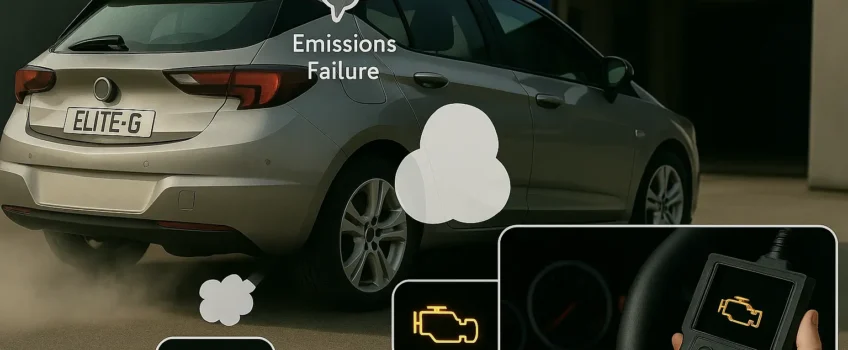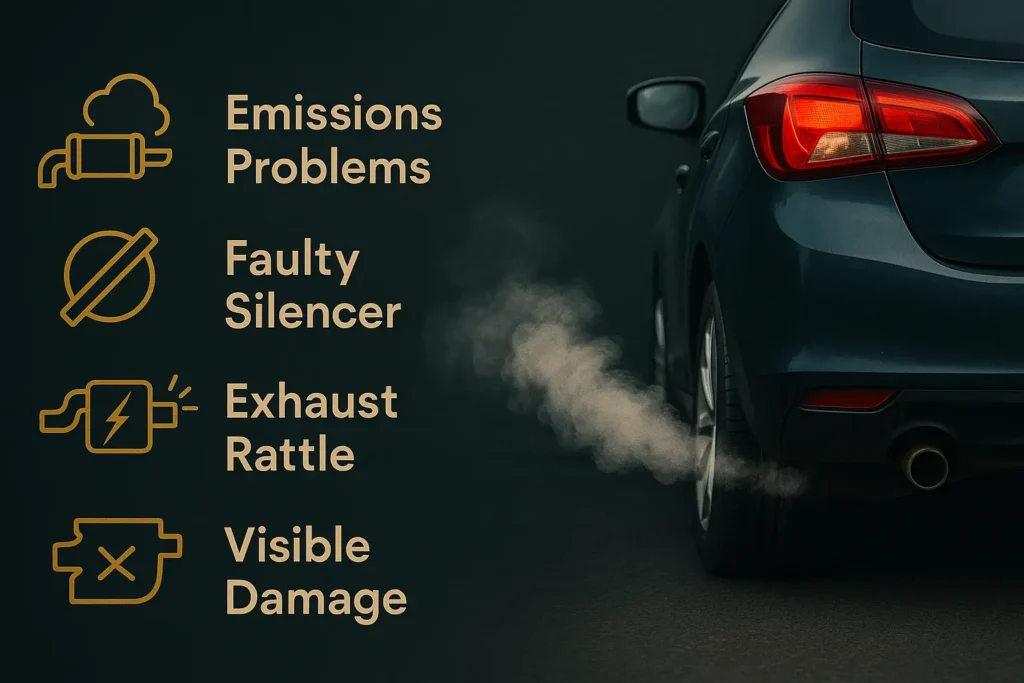
Exhaust Repair Guide: Emissions, MOTs and Warning Lights
Exhaust repair might not sound like a high priority until something goes wrong. From strange noises to warning lights and MOT failures, your vehicle’s exhaust system plays a critical role in performance, safety, and emissions.
Exhausts might not be the most glamorous of car components, but it’s certainly one of the hardest working. Responsible for reducing emissions, improving fuel efficiency and keeping your car running smoothly (and quietly), it plays a key role in both performance and environmental impact. When something goes wrong, it’s not just your engine that suffers, you could be facing a failed MOT or even long-term damage.
What Is the Role of the Exhaust System?
Your car’s exhaust system is designed to remove harmful gases produced during the combustion process and direct them safely out of the vehicle. It consists of several components: the exhaust manifold, catalytic converter, sensors, silencer (muffler) and exhaust pipe.
Together, they:
- Convert harmful emissions into less toxic gases
- Reduce engine noise
- Help maintain optimal engine performance
- Improve fuel efficiency
If any part of the system breaks or deteriorates like a cracked pipe or rusted silencer, you may notice reduced fuel economy, sluggish acceleration, or a rattling noise.
Common Signs You Might Need an Exhaust Repair
Some symptoms are easy to miss, but others are hard to ignore. If you notice any of these, it’s time to have your exhaust checked:
- Loud rattling or rumbling coming from underneath the car
- Decreased fuel efficiency
- Smell of exhaust fumes inside the car (very dangerous and you should seek immediate assistance)
- Visible rust, cracks, or holes in the exhaust pipe
- Dashboard engine warning light (amber or orange)
That last point can relate to a number of issues—from a faulty oxygen (O2) sensor to problems with emissions levels. Learn more about the meanings behind dashboard warning lights here.
Why Exhaust Repair Is Crucial for Your MOT
During your MOT, your exhaust system is examined for signs of damage or leakage, and your emissions are tested against UK legal limits. A faulty exhaust—or even a loose sensor—can cause your car to fail its MOT.
Some of the most common MOT failures linked to the exhaust system include:
- Excessive emissions
- Leaking or damaged components
- Noisy or loose exhaust systems
Read our full guide to MOT Failures and How to Avoid Them for more.
How Long Does an Exhaust Repair or Replacement Take?
Exhaust repairs can often be completed in under an hour, while full exhaust replacements may take between 1–3 hours depending on the vehicle type and level of damage. You can read more about this on Elite’s previous post: Car Exhaust Replacement – How Long Does It Take?
Our expert technicians use advanced diagnostic tools to pinpoint the problem quickly, whether it’s a broken catalytic converter, worn silencer or sensor issue. We only fit high-quality parts, and every repair is handled with precision and care.
Free Exhaust Checks at Elite Garages
Not sure if your exhaust needs attention? Drop into one of our many branches for a free exhaust check. We’ll inspect your system and let you know if a repair or replacement is needed; no obligation, just peace of mind. Book your free safety check now.

What Else Could the Engine Light Mean?
We’ve already mentioned it briefly, but your engine light doesn’t always mean something serious. Still, it’s never worth ignoring. It can be triggered by:
- Faulty O2 or NOx sensors
- Blocked or failed catalytic converter
- Fuel mixture problems
- Evaporative emissions control issues
A full diagnostic check will give you answers. At Elite, we offer car diagnostics using state-of-the-art equipment to uncover the root of the problem quickly and accurately.
Recommended: Find Car fuel and CO2 Emissions Data
Regular Maintenance Means Safer Driving
Whether it’s exhaust repair, cambelt replacement, or your annual MOT, staying on top of regular maintenance is the best way to avoid costly surprises. We recommend:
- Vehicle diagnostics if you see a warning light
- Annual servicing even if your MOT isn’t due
- Checking tyre tread and pressure before long journeys
- Brake inspections if you feel vibrations when stopping
Environmental Impact: Why Exhaust Repair Matters
A faulty exhaust system can lead to higher emissions, contributing to local air pollution and climate change. With growing environmental awareness and stricter emissions standards, keeping your exhaust system in good condition isn’t just about MOTs—it’s about doing your part for cleaner air. Regular checks and exhaust repair when needed are essential steps.
Related Services That Help Prevent Exhaust Damage
While exhaust repair is sometimes unavoidable, there are preventative services that help extend your exhaust system’s lifespan:
- Regular vehicle maintenance: Spot issues before they become costly problems.
- MOTs and diagnostics: Catch early signs of wear, corrosion, or faulty sensors.
- Brake inspections and tyre checks: A smooth-running car puts less stress on the exhaust.
If you’ve noticed any of the warning signs we’ve discussed, or if your vehicle just doesn’t sound or feel quite right, it’s always best to have it checked sooner rather than later. At Elite Garages, we offer expert exhaust repair and replacement services backed by decades of experience and the latest diagnostic technology.
FAQS: Exhaust Repair and Replacement Service
Click the + to read any answer or visit our most FAQ page to review the most frequently asked questions across all our Elite Locations.
If you click on a ‘Category’ or ‘Tag’ link, the page will ‘refresh’ and reload the page showing the top of the page first, you’ll then just need to scroll down to the FAQ section to see the results for the Category or Tag you selected.
If an exhaust has a hole or crack, it needs to be fixed right away. Not only can this cause #toxic fumes to enter your car’s cabin but it could also increase the risk of fire. An exhaust leak can cause the engine to run too hot or even fail due to lack of back-pressure from the silencer and tailpipe. If left unchecked, it may also result in increased emissions which could lead to failed emission tests and costly repairs.
A broken exhaust can produce a hissing sound, rattling, a low rumble or even a loud roar. It might be louder when you accelerate the engine and quieter when idling. In some cases, it may sound like air being sucked out of the engine instead of an actual noise. If something is wrong with your catalytic converter, you may experience a rattling sound that tends to get louder as the vehicle accelerates.
Depending on the make and model, how you drive, the environment it’s exposed to and regular maintenance checks; car exhausts can last the lifetime of the car. Generally built with either chrome or stainless steel, today’s car exhausts boast an impressive lifespan of 3 to 5 years but sometimes even more.
A faulty exhaust may result in #strange noises, reduced power and poor fuel economy, visible smoke or fumes, a rotten egg smell inside or outside the cabin and the engine dashboard light appear.
About Us
Opening Times
Saturday : 8:30–4:00
Sunday : closed
More Information
Contact UsCustomer Information Pack
Check MOT Due Date
Free MOT reminder
Careers
Legal Information
Recent Posts
- MOT in Dorchester: Keeping the South Coast Safely on the Move
- Car Battery Problems: Don’t Let a Dead Battery Flatten Your Day
- Bridgestone Tyres Promotion: Free Gift and Enter to Win £5,000
- Is Your Car Air Conditioning Ready for Autumn and Winter?
- Beyond Your Fareham MOT Centre: Tyres, Servicing, and Safety Checks


